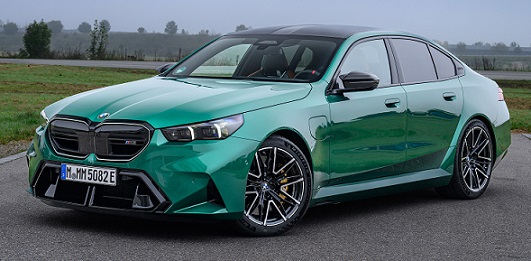

Sedan, 4 Doors, 5 Seats
585 Hp @ 5600-6500 rpm.
133.1 Hp/l
250 km/h, Electronically limited 155.34 mph
4395 cm3
268.2 cu. in.
8, V-engine
All wheel drive (4x4),
5096 mm
200.63 in.
1970 mm
77.56 in.
2435 kg
5368.26 lbs.
| Brand | BMW |
|---|---|
| Model | M5 (Sedan) |
| Version | M5 (G90) |
| Engine version | 4.4 V8 (727 Hp) Plug-in Hybrid M xDrive M Steptronic |
| Year production start | 2024 |
| Vehicle type | Sedan |
| Horsepower RPM | 585 Hp @ 5600-6500 rpm. |
| Acceleration 0 - 100 kmh sec | 3.5 sec |
| Curb weight kg -lbs total |
2435 kg5368.26 lbs. |
| Overall length mm - inch |
5096 mm200.63 in. |
| Doors | 4 |
| Top Speed | 250 km/h, Electronically limited 155.34 mph |
| Designation model | S68B44T0 |
|---|---|
| Cam configuration | VALVETRONIC, Double-VANOS |
| Engine position and orientation | Front, Longitudinal |
| Cylinders | 8 |
| Position of cylinders | V-engine |
| Displacement (liters) |
4395 cm3268.2 cu. in. |
| Eng. horsepower RPM | 585 Hp @ 5600-6500 rpm. |
| Horsepower per litre | 133.1 Hp/l |
| Weight / horsepower kg/hp - hp/tons |
3.3 kg/Hp298.6 Hp/tonne |
| Weight / torque kg/Nm - Nm/tons | 2.4 kg/Nm, 410.7 Nm/tonne
2.4 kg/Nm410.7 Nm/tonne |
| Torque Nm RPM lb-ft RPM |
750 Nm @ 1800-5400 rpm.553.17 lb.-ft. @ 1800-5400 rpm. |
| Bore (mm in) |
89 mm3.5 in. |
| Stroke (mm in) |
88.3 mm3.48 in. |
| Compression ratio | 10.5:1 |
| Fuel delivery system | Direct injection |
| Fuel type | Petrol / electricity |
| Valvetrain | 4 |
| Engine aspiration | Twin-power turbo, Intercooler |
| Engine oil liters | quarts |
13.2 l13.95 US qt | 11.61 UK qt |
| Emission certification | Euro 6e |
| Powertrain architecture | PHEV (Plug-in Hybrid Electric Vehicle) |
| Electric motor power | 197 Hp @ 6000 rpm. |
| Electric motor torque | 280 Nm @ 1000-5000 rpm. 206.52 lb.-ft. @ 1000-5000 rpm. |
| Engine location | Front, Longitudinal |
| Total available power | 727 Hp |
| Totale available torque | 1000 Nm 737.56 lb.-ft. |
| Drive configuration | All wheel drive (4x4) |
|---|
| Front brakes | Ventilated discs, 410 mm |
|---|---|
| Rear brakes | Ventilated discs, 398 mm |
| Anti-lock brake system | ABS (Anti-lock braking system) |
| Steering type | Steering rack and pinion |
|---|---|
| Turning diameter m - ft |
12.6 m41.34 ft. |
| Front suspension | Coil spring, Double wishbone, Transverse stabilizer |
|---|---|
| Rear suspension | Independent multi-link spring suspension with stabilizer |
| Wheels size | Front wheel tires: 285/40 ZR20 |
|---|---|
| Wheels rims | Front wheel rims: 10.5J x 20 |
| Passengers seats | 5 |
|---|---|
| Trunk space min liter | cu. Ft. |
466 l16.46 cu. ft. |
| Roof load load kg lbs |
75 kg165.35 lbs. |
| Overall length mm - inch |
5096 mm200.63 in. |
|---|---|
| Overall width mm -inch |
1970 mm77.56 in. |
| Overall height mm -inch |
1510 mm59.45 in. |
| Wheelbase mm - inch |
3006 mm118.35 in. |
| Track width front mm - inch |
1684 mm66.3 in. |
| Track width rear mm - inch |
1660 mm65.35 in. |
| Coefficient of drag | 0.32 |
| Curb weight kg -lbs total |
2435 kg5368.26 lbs. |
|---|---|
| Gross weight kg -lbs total |
2940 kg6481.59 lbs. |
| Capacities kg - lbs |
505 kg1113.33 lbs. |
| Fuel tank liters | gallons |
60 l15.85 US gal | 13.2 UK gal |
8 CYLINDER V-Engine
https://www.thecarspec.net/components/engine/8-cylinders-v